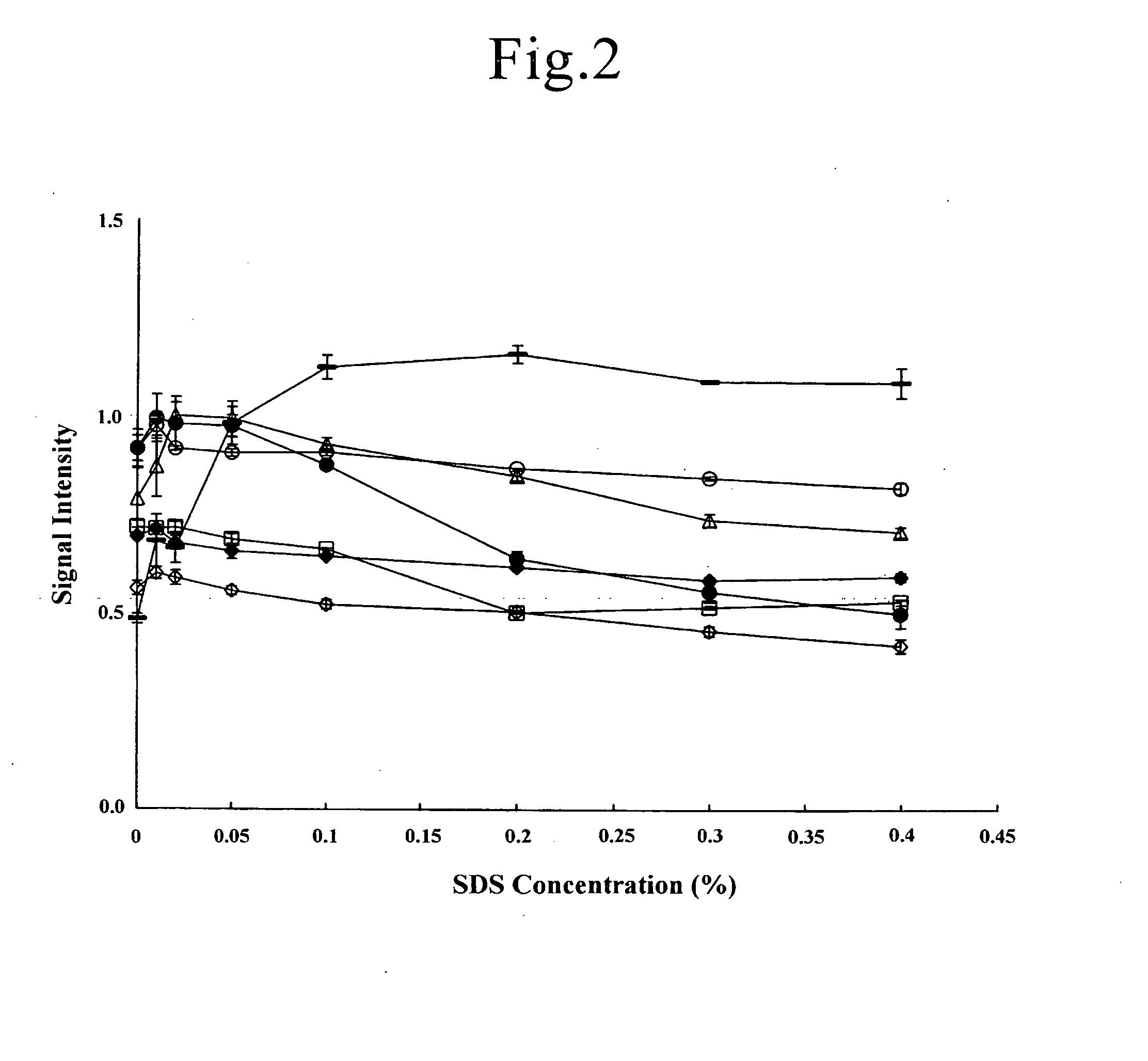Protein Immobilization Method and Quantification Method
a protein and immobilization method technology, applied in the field of protein immobilization method and quantification method, can solve the problems of inability to accurately quantitatively determine a protein, inability to perform accurate measurement of proteins, and inability to immobilize proteins at a constant rate on the membrane, etc., to achieve rapid and highly precise detection of prion disease, high immunoblotting sensitivity, and rapid and highly precise effect of immobilization
- Summary
- Abstract
- Description
- Claims
- Application Information
AI Technical Summary
Benefits of technology
Problems solved by technology
Method used
Image
Examples
example 1
Preparation of Sample and Reagent Solution
(1) Protein Sample
[0132]Ovalbumin (hereinafter designated as OVA, derived from chicken egg albumin, Wako Pure Chemical Industries, Ltd.), hemoglobin (derived from bovine blood, Wako Pure Chemical Industries, Ltd.), IgG (derived from bovine, Wako Pure Chemical Industries, Ltd.), cytochrome c (derived from horse cardiac muscle, Wako Pure Chemical Industries, Ltd.), and lysozyme (derived from chicken egg albumin, Wako Pure Chemical Industries, Ltd.), were weighed and dissolved in purified water to prepare a solution of 250 μg / mL each as the protein sample.
(2) Immobilizing Reagent Solution
[0133]Each reagent was dissolved in purified water to prepare the following immobilizing reagent solutions. Among them, the immobilizing reagent solutions 3 to 5 are the immobilizing reagent solutions of the present invention.
[0134]In each reagent, ethanol (Wako Pure Chemical Industries, Ltd., Reagent grade), trichloroacetic acid (hereinafter designated as TCA....
example 2
Preparation of Sample and Reagent Solution
(1) Protein Sample
[0144]Lysozyme, cytochrome c, IgG, fibrinogen (derived from human plasma, Wako Pure Chemical Industries, Ltd.), BSA (bovine serum albumin, Wako Pure Chemical Industries, Ltd.), OVA, trypsin inhibitor (derived from soy bean, Wako Pure Chemical Industries, Ltd.), and hemoglobin were weighed and dissolved in purified water to prepare a solution of 250 μg / mL each as the protein sample. These proteins have a wide range of the isoelectric points of pI 4.0 to 11.4, and the molecular weights of 12,000 to 150,000 (refer to Kubo et al., Tanpakushitu in “Seikagaku Handbook” Maruzen K.K., 54-57 (1984)).
(2) Immobilizing Reagent Solution
[0145]Solutions containing 2.5% (W / V) TCA, 45% (V / V) ethanol and given concentrations (0 to 0.4% (W / V)) of SDS were prepared by dissolving each reagent in purified water to use as the immobilizing reagent solutions.
(3) Immobilization Sample
[0146]A predetermined protein sample in an amount of 20 μL (protei...
example 3
Examination of Lower Alcohol
[0160]Immobilization and determination of protein samples were performed where methanol was used in place of ethanol as the lower alcohol.
Preparation of Sample and Reagent Solution
(1) Protein Sample
[0161]BSA, OVA, hemoglobin, IgG, cytochrome c and lysozyme were weighed and dissolved in purified water to prepare a solution of 250 μg / mL each as the protein samples.
(2) Immobilizing Reagent Solution
[0162]The following immobilizing reagent solutions were prepared by using purified water.
Immobilizing reagent solution 1: 0.2% (W / V) SDS, 2.5% (W / V) TCA;
Immobilizing reagent solution 2: 0.2% (W / V) SDS, 2.5% (W / V) TCA, 45% ethanol;
Immobilizing reagent solution 3: 0.2% (W / V) SDS, 2.5% (W / V) TCA, 45% methanol (Wako Pure Chemical Industries, Ltd., Reagent grade).
(3) Immobilization Sample
[0163]Each protein sample in an amount of 20 μL (protein 5 μg) and 300 mL of a given immobilizing reagent solution were mixed to prepare the immobilization sample 1, the immobilization ...
PUM
| Property | Measurement | Unit |
|---|---|---|
| Fraction | aaaaa | aaaaa |
| Fraction | aaaaa | aaaaa |
| Fraction | aaaaa | aaaaa |
Abstract
Description
Claims
Application Information
 Login to View More
Login to View More - R&D
- Intellectual Property
- Life Sciences
- Materials
- Tech Scout
- Unparalleled Data Quality
- Higher Quality Content
- 60% Fewer Hallucinations
Browse by: Latest US Patents, China's latest patents, Technical Efficacy Thesaurus, Application Domain, Technology Topic, Popular Technical Reports.
© 2025 PatSnap. All rights reserved.Legal|Privacy policy|Modern Slavery Act Transparency Statement|Sitemap|About US| Contact US: help@patsnap.com



